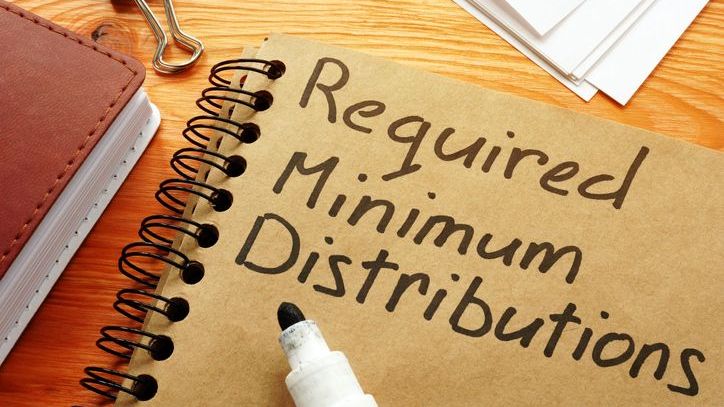
If I turn 73 in 2025 and take out my first RMD before Dec. 31, 2025, it would be 2025 income. If I wait until the April 1, 2026 deadline for RMDs, would the withdrawal still count as 2025 income? I still have to take another RMD before Dec. 31, 2026, which would be 2026 income. I just want to avoid two taxable events in the same year.
– Ron
Whether you take your first required minimum distribution (RMD) in 2025 or delay it until 2026, I can see how you might assume it would count as income in 2025. But distributions are taxed in the year they occur. If you wait until 2026 to take your first RMD, the money would simply count as income in 2026. As a result, you’d be required to take two RMDs the following year. RMDs can significantly impact your tax situation in retirement, but a financial advisor can help you plan for these mandatory withdrawals.
First Year RMD
Let’s give a little background to readers who may not understand the basis of your question.
Starting at age 73, you must take required minimum distributions (RMDs) from your ‘tax-deferred retirement accounts each year. You can easily calculate how much you’ll need to withdraw by dividing your account balance at the end of the previous year by your life expectancy factor – a number that corresponds with your current age. Most people can find their life expectancy factor on the IRS’s Uniform Lifetime Table.
You’ll need to withdraw an amount at least equal to your RMD by December 31 each year. However, there’s an exception to this rule: you can delay your first RMD until April 1 of the following year.
For example, let’s say you want to calculate your RMD for 2025 and you had $1 million in a traditional IRA on Dec. 31, 2024. You would divide that value by the life expectancy factor for someone who’s 73 – 26.5 – to get an RMD of $37,735. You then would have to withdraw that much from your IRA by April 1, 2026. And if you need help calculating your RMDs or figuring out what to do with the money, consider speaking with a financial advisor.
RMDs and Taxation

RMDs are designed to ensure that money in tax-deferred retirement accounts isn’t held indefinitely as a permanent tax shelter or wealth transfer tool. The fact that they are included in your taxable income is a feature, not a bug, of the RMD rules. However, there are some steps you can take to reduce or avoid paying taxes on RMDs over the long term. The earlier you start planning for RMDs, the more you can do.
As you pointed out, Ron, if you delay your first RMD (for 2025) until the following April you will still be required to take an RMD for 2026, too. That one will have to come out by Dec. 31, 2026, giving you two taxable RMDs in 2026.
So, for simplicity’s sake, let’s say your first two RMDs will both equal $38,000. That would mean you’d have $76,000 in income from RMDs in 2026. That would leave you with a higher tax bill, and potentially, in a higher tax bracket in 2026. If you need help planning for RMDs or calculating their impact on your taxes, consider working with a financial advisor.
How to Avoid Two Taxable RMDs in One Year

Of course, the easiest way to avoid two taxable events in 2026 is to take your first RMD by Dec. 31, 2025.
However, you could also make a qualified charitable distribution (QCD) in 2026. QCDs allow you to donate up to $105,000 from your IRA (2024 limit) directly to a qualified charitable organization without including that distribution in your income, while also satisfying your RMD.
Note that this is not the same as taking your RMD, donating the cash to a charity and then claiming a deduction. That requires you to recognize the RMD as income first. You can then only take the deduction if you itemize.
While you can utilize QCDs even if you don’t itemize, here are a couple of things to keep in mind:
- You can’t deduct a QCD. Remember, you never included the RMD in your income to begin with, so claiming a deduction would be double-dipping.
- Only make a QCD if you can afford it. Make sure you aren’t chasing a tax benefit at the expense of having adequate cash flow. If you need the RMD to cover expenses or for other reasons, a QCD may not make sense.
A financial advisor can help you plan your QCDs and make other decisions surrounding your money in retirement.
Bottom Line
RMDs are taxed in the year you receive them. While the IRS allows you to delay your first RMD until April 1 in the year after you turn 73, you still have to take the RMD for that year, too. Since both RMDs would be subject to income taxation, you could owe significantly more in taxes. On the other hand, you can take your first RMD during the same year that you turn 73. If not, a QCD may be a good option, if charity is a priority.
RMD Planning Tips
- The first step in planning for RMDs is calculating how much you’re required to withdraw. Luckily, SmartAsset has a tool specifically designed to help you do that. Simply add your current age, account balance and expected rate of return and the calculator will estimate how much your RMD could be.
- A financial advisor can help you build a retirement income plan that includes your RMDs. Finding a financial advisor doesn’t have to be hard. SmartAsset’s free tool matches you with up to three vetted financial advisors who serve your area, and you can have a free introductory call with your advisor matches to decide which one you feel is right for you. If you’re ready to find an advisor who can help you achieve your financial goals, get started now.
Brandon Renfro, CFP®, is a SmartAsset financial planning columnist and answers reader questions on personal finance and tax topics. Got a question you’d like answered? Email AskAnAdvisor@smartasset.com and your question may be answered in a future column. Questions may be edited for clarity or length.
Please note that Brandon is not a participant on the SmartAsset platform, and he has been compensated for this article. Questions may be edited for clarity or length.
Photo credit: ©iStock.com/supersizer, ©iStock.com/designer491